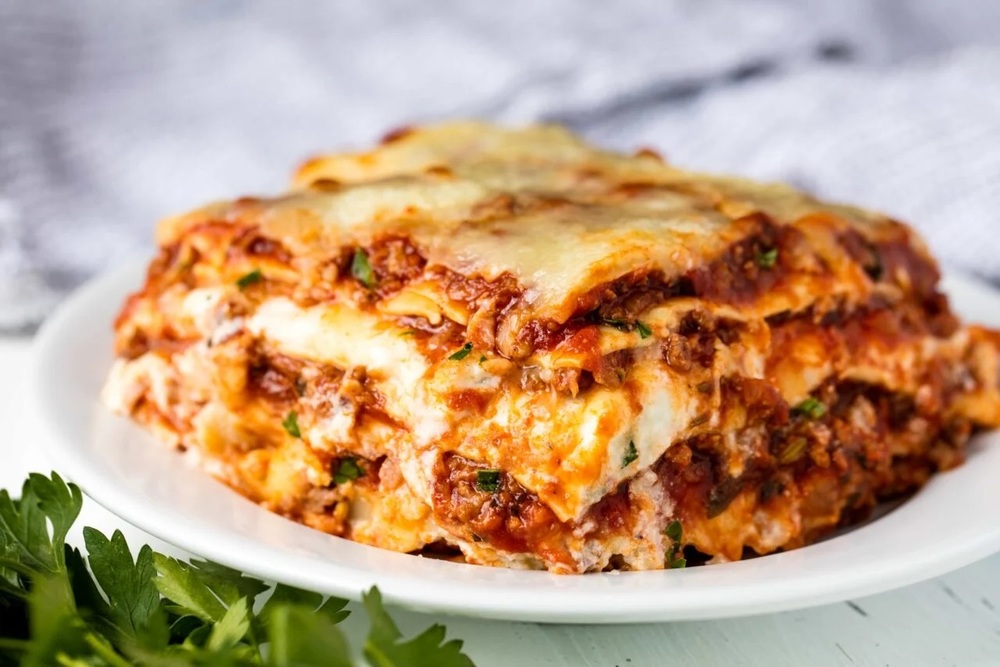It’s a common misconception that making a lasagne from scratch at home is time-consuming and labour intensive, but that’s not always so – particularly if you make some of the components ahead of time. You can even use leftover roasted meat to make a quicker ragù, or ricotta cheese in place of a white sauce.
Here’s how to cook lasagne in a variety of ways that’ll suit both vegetarians and the biggest meat-eaters.
A really authentic ‘ragù’ meat sauce is best made with leftover roasted meat. If you don’t have any to hand, try slow-cooking some shredded shin of beef and belly pork, along with onions, celery, carrots, garlic and tomatoes. The longer it cooks, the better it tastes. You can easily prepare this in a slow cooker ahead of time.
You can also use minced meat, such as pork and beef, flavoured up with bacon, red wine and plenty of herbs to make this versatile meat ragù. Again, make sure you give the sauce plenty of simmering time on the stove.
For something completely different and a bit indulgent, this crispy duck lasagne is made by shredding up the meat from a whole roasted duck and creating a ragù with red wine, tomatoes, fresh marjoram and spinach. It’s layered up with a traditional white sauce and topped with ‘pangrattato’, which is made from stale bread or breadcrumbs. This one is a real labour of love, but well worth it if you’re feeding a crowd or catering for a special occasion.
Vegetarian versions are not only bursting with exciting flavours and textures, but they’re often quicker to prepare because the sauce won’t need quite as much simmering time.
For a quick, weeknight family supper, I often make a sweet leek, ricotta and tomato lasagne. You don’t even have to make a white sauce for this one; simply stir through a tub of good quality ricotta cheese to make the creamy leek, onion and fresh spinach layer. I like to add my own sliced, roasted courgettes. Just slice them, drizzle with olive oil, and grate over a little lemon zest, before baking for ten minutes in a pre-heated oven (which you can leave running once they’re done to bake your finished lasagne a short while later).
Roasted vegetables in general work particularly well in vegetarian lasagne. Try either thin layers or chunkier pieces of griddled aubergine, mixed peppers, courgettes, onions and butternut squash, layered up with a simple white, béchamel sauce.
You can also make this recipe ahead by layering up your lasagne into some ovenproof dishes or mini foil containers and freezing. It will keep well in the freezer for up to three months.

How to layer up a lasagne
To build up the layers of your lasagne, have your ingredients and sauces ready and to hand. I like to use fresh lasagne sheets, which you can buy in the fresh pasta section in the supermarket – they can go straight in and there’s no need to pre-cook the pasta sheets at all.
Start by spreading a layer of your tomato-based sauce (either a plain tomato sauce or your pre-made ragù) on the bottom of your dish. Next, add a single layer of pasta sheets. Then, add a layer of white sauce, followed by another single layer of pasta sheets. Carry on alternating the tomato sauce, lasagne sheets and white sauce until you get to the top of the dish, or your sauces run out!
Finish off your lasagne either with a layer of tomato-based sauce or with your white sauce – whichever you have left – and then grate over plenty of Parmigiano-Reggiano. A common extra topping is torn mozzarella, which makes a lovely, melted cheesy layer on top.
A lasagne is always oven-baked, so be sure to remember to pre-heat your oven to around 200°C/400°F/gas 6. It’s best to cover your lasagne with tin foil for the first thirty minutes and then remove the foil and bake for a further 10-20 minutes, until the top is golden and crispy and the whole dish is piping hot through.
How to Layer Lasagna
What makes a good lasagna?
Making a great lasagna is more than just putting a recipe together and throwing good quality ingredients into a tray. It’s about understanding the structural integrity of the dish. It’s about knowing what goes where, and how the different layers of this dish are meant to interact together.
Can one eat lasagna?
Lasagna can be eaten, but we must know what the person needs, or better. If you seek weight loss, or control the consumption of pasta and cheese. If you are looking for weight loss, it is advisable to replace the layers of pasta with vegetables, such as zucchini or eggplant, helping to balance the nutritional value.
What can you add to lasagna?
Minced beef, chicken, or pork can make excellent additions to your lasagna. If you’re making a vegetarian lasagna, consider laying out sliced mushrooms, zucchini, or fresh spinach to add to your layers. Choose a no-boil or regular lasagna noodle. When it comes to lasagna, there are 2 types of noodles to choose from: no-boil or regular.
How do you make lasagna?
Here’s how. However you make lasagna, there is one rule you should always follow: Start with sauce. Whether you are using a baking dish or a skillet, there needs to be an even layer of sauce covering the entire bottom of the pan before any of the other ingredients are added.
